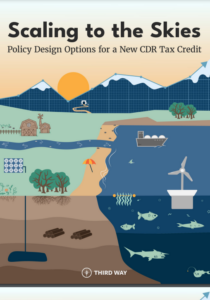Full Title: Scaling to the Skies
Author(s): Anisah Assim, Kyle Danish, Michael Platner, Patrick Reimherr, and Dr. Rudra V. Kapila
Publisher(s): Third Way
Publication Date: October 23, 2023
Full Text: Download Resource
Description (excerpt):
It is likely that within the next 5 years the world will reach 1.5 degrees of warming, exceeding the target cap on warming agreed to in the Paris Climate Accords. The effects of exceeding this target are dire and cannot be understated, but it is notable that the Intergovernmental Panel on Climate Change (IPCC) envisions scenarios where it is possible to return to a level of warming below 1.5 degrees and avoid breaching the 2.0-degree threshold. Those scenarios are achieved by rapidly pursuing decarbonization while simultaneously deploying Carbon Dioxide Removal (CDR). It is projected that to achieve that level of deployment the world will need to increase traditional land-based CDR methods by two-fold and nascent, generally technologically-based, CDR methods by 1,300 – 4,900-fold.
This task will not be small. It is also further complicated by the underlying economics of CDR methods. CDR is primarily a public good, even if it does have the potential to yield some marketable byproducts. That means that there is not an inherent existing market for the removal components of CDR methods. To successfully scale CDR, drive down the price of the methods that create removal, and build long-term markets for CDR it is necessary to enact robust policies that support CDR.
Currently, the United States supports a limited quantity of CDR methods through the existing 45Q tax credit. However, it is expected that it will not be possible to achieve the requisite level of removal needed by using these methods alone. Thankfully, there are multiple existing CDR methodologies beyond those supported by 45Q and as the field rapidly grows it is plausible that new ones will be created in the future.
This paper explores how a new method-neutral CDR tax credit can help these methods deploy at the pace and volumes needed. This paper is intended to be used as a policy-agnostic reference on how to design a CDR tax credit.
